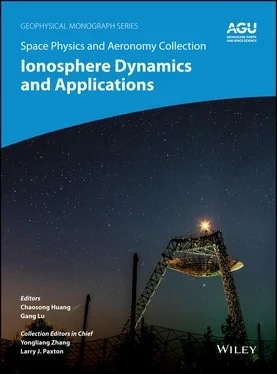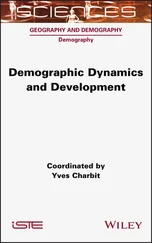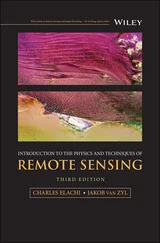(2.11) 
where the value of the integral is independent of the path taken (a requirement for a conservative force that can be represented by a potential). The convection electric field is usually presented as a contour plot of the equipotentials of Φ, as for instance in Figure 2.1. The expression for E× Bdrift can be written
(2.12) 
which indicates that the ionospheric flow is perpendicular to B(i.e., roughly horizontal) and perpendicular to the gradient in Φ, or in other words that equipotentials of Φ are equivalent to streamlines of the flow.
From equation (2.5), it is apparent that Eis perpendicular to B, which can be written as B∙ E= 0 or B∙ ∇ Φ = 0. This indicates that there is no gradient of Φ along the magnetic field direction, that is, field lines are also equipotentials of Φ. This is the same as saying that the component of the electric field parallel to the magnetic field is zero, E ‖≈ 0, which occurs because electrons are highly mobile along the magnetic field and can arrange themselves to nullify any field line voltage. If changes in the magnetospheric Bfield are assumed to be slow, the electric field distribution represented by Φ can be “mapped” upward along magnetic field lines to infer the electric field throughout the magnetosphere. In early models of convection, it was assumed that this electric field originated in the solar wind flow and mapped down along open magnetic field lines to drive E× Bdrift in the ionosphere (e.g., Stern, 1973; Lyons, 1985; Toffoletto & Hill, 1989). However, when temporal changes in magnetosphere/ionosphere convection are considered, and induced electric fields become important, it is clear that this view is too simplistic. Instead, the physics of stress balance, outlined above, comes to the fore (e.g., Parker, 1996; Vasyliunas, 2005).
The potential difference (or voltage) between two positions A and B in the convection pattern (in the ionosphere or anywhere in the magnetosphere) is
(2.13) 
This is a measure of the amount of magnetic flux frozen into the flowing plasma that is carried across any path between A and B in unit time, that is ∆Φ represents the rate of transport of magnetic flux in the convection. The “cross‐polar cap potential” (CPCP) or “transpolar voltage,” usually written Φ PC, is defined as the voltage between the dawn and dusk sides of the polar cap, a measure of the antisunward magnetic flux transport in the Dungey cycle. If the polar cap is 2,000 km across and the antisunward flow speed is 500 km s −1(an electric field of 25 mV m −1), then Φ PCis 50 kV.
2.3.2 Convection, Corotation, and Dawn‐Dusk Asymmetries
The twin‐cell convection pattern does not extend to the equator but is confined to high latitudes, which can be understood by considering the competition between the reconnection‐driven Dungey cycle and “corotation” (that is, rotation with the planet), as described by Wolf (1970) and Volland (1973). The magnetospheric ends of the field lines move under the influence of the Dungey cycle flow discussed previously, whereas the ionospheric ends experience ion‐neutral collisions with the corotating atmosphere. In the equatorial plane, the Dungey flow consists of sunward magnetic flux transport (e.g., Fig. 2.2b), which can be represented by a voltage between the dawn and dusk flanks of the magnetosphere (equal to Φ PC), corresponding to some constant electric field E 0( Fig. 2.5a). Corotation exerts a force to make the plasma follow circular trajectories at the Earth's rotational angular frequency ( Fig. 2.5b). The combined convection and corotation potential is shown in Figure 2.5c. A teardrop‐shaped inner core of the magnetosphere corotates with the planet, avoided by the Dungey flow outside; a point of flow stagnation exists along the dusk meridian where the Dungey cycle and corotation forces cancel. Ionospheric plasma can accumulate in the inner region to form the plasmasphere, whereas the outer region is constantly replenished by plasma of solar wind origin from the magnetotail. The boundary between these two regions marks the equatorward edge of the high‐latitude convection pattern in the ionosphere. As the convection voltage increases, the stagnation point moves toward the Earth and the ionospheric convection pattern expands equatorward.

Figure 2.5 Plasma flow in the equatorial plane of the magnetosphere. (a) The Dungey cycle contribution to cold plasma flow, associated with a dawn‐to‐dusk convection electric field E 0. Flow streamlines are also contours of the convection electrostatic potential Φ, where Φ 1< Φ 2< Φ 3, etc. (b) The corotation contribution to cold plasma flow. (c) The resultant flow, giving rise to Dungey cycle flow in the outer magnetosphere and corotation in the inner magnetosphere, where the plasmasphere forms (shaded). A flow stagnation point exists along the dusk meridian. (d) Convection and gradient‐curvature drift of hot electrons. (e) Convection and gradient‐curvature drift of hot protons. (f) The effect of displacing the plasma sheet (shaded) sunward by convection: where gradient‐curvature drift paths (dotted circles) intersect the inner edge of the plasma sheet, divergence of the partial ring current leads to the formation of field‐aligned currents that form the region 2 FAC system.
This picture is appropriate for cold plasma, that is the bulk of the plasma sheet particles with gyroradii that are small with respect to the radial magnetic field gradient in the inner dipole. Hot plasma convects earthward from the magnetotail as described above, but experiences gradient‐curvature drift in the inner magnetosphere, with ions and electrons encircling the Earth to the west and east, respectively ( Fig. 2.5d and e). This differential ion and electron flow constitutes a westward “ring current.” In addition, divergence of magnetization current in pressure gradients at the inner edge of the earthward‐convecting plasma sheet forms a “partial ring current,” with associated currents flowing along magnetic field lines between the equatorial plane and the polar ionosphere, as shown in Figure 2.5f (Cowley, 2000; Ganushkina et al., 2015). The ramifications of this are discussed in section 2.3.3.
Within the polar cap, the flow is antisunward, associated with flux sinking through the lobes toward the neutral sheet as new open flux is created at the magnetopause and flux is removed from the central plane of the tail as it is reclosed. An additional force on the polar cap field lines needs to be considered when the east‐west or B Ycomponent of the IMF is nonzero. If we assume that B Y> 0 in Figure 2.2a, then the northern and southern ends of the newly reconnected field lines are tilted into and out of the page. This exerts a magnetic tension force on the footprints of the field‐lines causing westward and eastward flow in the dayside northern and southern polar caps, respectively (e.g., Heelis, 1984; Reiff & Burch, 1985; Cowley et al., 1991), with the situation reversed for B Y< 0. The flows crossing the dayside polar cap boundary are directed westward in Figure 2.3b, appropriate for B Y> 0 in the Northern Hemisphere. Under strong IMF B Yconditions, the torque exerted by the magnetic tension on the northern and southern lobes can lead to a significant twist on the tail and an induced B Ycomponent in the lobe field lines that can then introduce east‐west asymmetries into the convection flow on the nightside.
Читать дальше
















